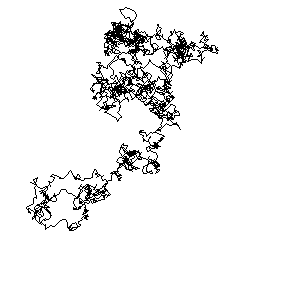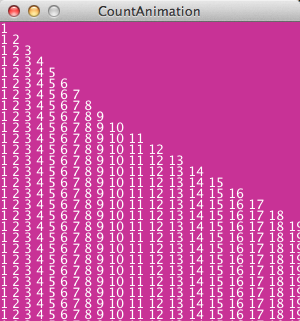Objectives
Students who complete this lab will demonstrate that they can:
- Implement graphical animations
- Implement interactive human-computer interfaces
Digital Animation
Processing supports the digital animation of a variety of
geometric figures.
|
This program models the semi-random movement of an object in 2D
space using Brownian
motion . You can animate this behavior by setting a fixed starting point
and then repeatedly varying the x and the y coordinates by a small,
random amount.
. You can animate this behavior by setting a fixed starting point
and then repeatedly varying the x and the y coordinates by a small,
random amount.
You can run the animation by clicking on the animation image
to the right. You must have the Java runtime environment (JRE)
installed for this to work and you may need to enter the course
materials password.
|
 |
Exercise 4a.1
Write an animation program named
Scribbler
whose output is like the one shown above (save all of your code for
this lab in a directory called
lab04a
). Start your scribble in the middle of the output pane and move it a
short random distance away from its current position on each
successive frame. Ensure that it never leaves the visible part of the
canvas shown in the output pane.
To implement the animation, you can follow an algorithm such as
this one:
- Data: x & y coordinates (float)
- Setup:
- Set the output panel size.
- Initialize x & y to the center of the output panel.
- Draw:
- Set
newX and newY equal to new
x-y coordinate values that are a small random distance away from
where x and y were in the previous frame
(Note that you can invoke the predefined random
method
random
method to compute a small random number around 0 and the constrain
method
to compute a small random number around 0 and the constrain
method to ensure that the new coordinates are on the visible output
pane);
to ensure that the new coordinates are on the visible output
pane);
- Draw a line from the previous coordinates (
x,
y) to the new coordinates (newX, newY);
- Set the old coordinates (
x, y)
equal to the new coordinates (newX, newY)
- this ensures that the new coordinate values will be saved and
used as the starting point in the next iteration.
Note that in this algorithm the scope of the coordinates
(x, y)
is global to the whole program while the scope of
(newX, newY)
is local to the
draw()
method. When you have your program running, take a moment to ask
yourself these questions:
- Could we make
x and y local to draw()?
Would the animation still run?
- Could we make
newX and newY
global? Would it be good idea to do it that way?
Include brief answers to these questions in your program
documentation.
Human-Computer Interaction
Processing also supports mouse-based interaction between the
user and the program.
Exercise 4a.2
|
Save a copy of your Scribbler from above as
InteractiveScribbler
and modify it as follows:
Modify the copy so that it re-sets the random
scribbling to the location specified by the mouse click. Your
program should produce output that looks something like the one
shown on the right.
You can implement this by adding a
mousePressed()
method to your current prototype that changes the saved
(x, y)
coordinates to the coordinates of the most recent mouse press
(stored automatically by Processing in the
mouseX
and
mouseY
variables).
Once you have the above version working, improve
your code so that each time the user presses the mouse, the
color of the lines being drawn is changed to a random color. Do
you need a global variable to make this change?
Save this version of your program so that you can turn it in
later.
|
 |
Although Processing requires that the
draw()
method be defined for all animation and interaction programs, it
doesn’t require that that method contain code. It could be
defined to do nothing:
void draw() { }
This can be used in programs that respond to user-initiated
events only and not to a pre-defined frame rate.
Exercise 4a.3
|
Create an interactive program called
Tracer
that allows the user to scribble manually. Your program should
allow the user to create output that looks something the one shown
on the right by pressing and dragging the mouse around on the
output pane.
You can implement this by using an empty
draw()
method (required for animation) and then writing a
mouseDragged()
method that draws a line from the previous mouse location
(pmouseX, pmouseY)
to the current mouse location
(mouseX, mouseY)
. Note that with this implementation, your program doesn't need to
declare/define any new variables, because Processing already
stores the current and previous location of the mouse.
Use this version of your program in the next exercise.
|
 |
Processing applications can also respond to key-pressing events.
Exercise 4a.4
Modify your program from the previous exercise so that when the user
presses any key on the keyboard, the program dumps the current image
to a JPG image file. You can implement this by adding a
keyPressed()
method that calls the save() method. Save the image
using a hard-coded filename each time. Be sure that you can find the
image file that Processing dumps. Hint: Where does Processing like to
put auxiliary files?
method. Save the image
using a hard-coded filename each time. Be sure that you can find the
image file that Processing dumps. Hint: Where does Processing like to
put auxiliary files?
Save this final version of your
Tracer
program so that you can turn it in later.
Character and String Expressions
In the previous lab we explored numeric types, but there are many
others at our disposal.
Exercise 4a.5:
-
What do the following statements do (if anything)? You will
want to evaluate each statement in turn. If any are invalid,
comment them out, and note the error.
char char1 = 'H';
char friendlyChar = 'Hi';
char emptyChar = '';
String string1 = char1;
String emptyString = "";
Explain your results.
-
What is the return value of the following expressions (if
any)?
"All your base" + "are belong to us."
"Somebody" + ' ' + "set us up the bomb."
"A.D. " + 2101
Explain your results.
Exercise 4a.6
Create a program called CountAnimation that
produces the output shown here, with one line appearing each frame.
You can do this as follows:
- Data: The current line number (an int) and the current output (a String)
- Setup:
- Make the output window 300 pixels wide and high
- Change the background color to something other than
gray
- Initialize the line number to be 1 and the output to be the
String 1.
- Draw:
- Use
text() to place the current output
string at a location dependent on the current line number.
- Update the line number to increase by 1.
- Update the output to append a space and the new line number.
|
 |
The default font is fine, but if you would like to use a different
one, update your code appropriately.
Checking In
Submit all the code and supporting files for the exercises in
this lab. We will grade this exercise according to the following
criteria:
- Correctness:
- 60% - Programs - Complete the first four of the programming
exercises (15% each).
- 10% - Scope - Demonstrate an understanding of scope by
including the answers to the questions in exercise 4a.1 in that
program’s comments.
- 5% - Character and String Expressions - Complete accurate
explanations of each expression.
- 15% - Count Animation - Complete the animation exercise.
- Understandability:
- 5% - Header Documentation - Document the code’s basic
purpose, authors and assignment number.
- 5% - Code Documentation - Separate the logical blocks of
your programs with useful comments and white space.
 . You can animate this behavior by setting a fixed starting point
and then repeatedly varying the x and the y coordinates by a small,
random amount.
. You can animate this behavior by setting a fixed starting point
and then repeatedly varying the x and the y coordinates by a small,
random amount.





